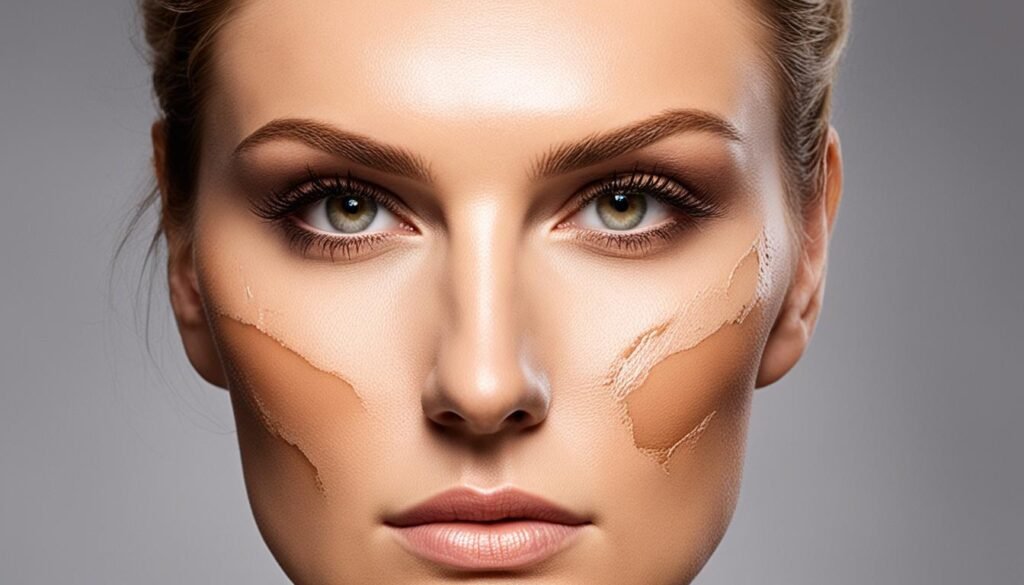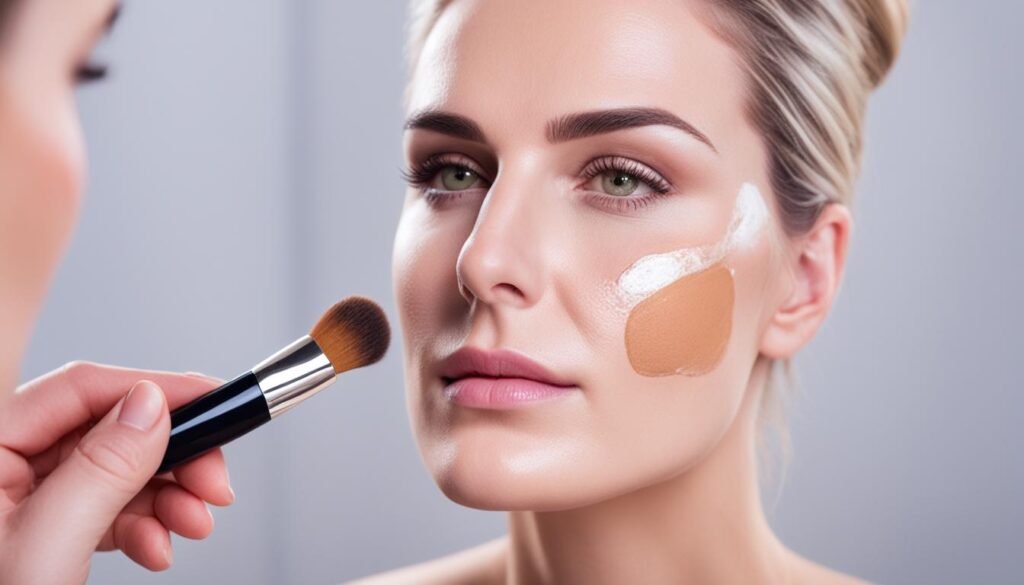Scarring is a natural part of the body’s healing process, but for many, scars can be a source of self-consciousness. If you’re looking to reduce the appearance of scars and feel more confident, there are makeup techniques you can use. Whether you have acne scars, keloid scars, or hypertrophic scars, the right makeup can help you achieve a flawless complexion and boost your self-esteem.
But how exactly can you hide scars with makeup? What are the best techniques and products to use? Is it possible to achieve long-lasting coverage without looking cakey or unnatural?
In this comprehensive guide, we’ll explore the answers to these questions and more. From choosing the right foundation and concealer to color correcting techniques and camouflaging strategies, we’ll cover everything you need to know to effectively hide scars with makeup. Get ready to discover the power of cosmetics and unleash your confidence!
Key Takeaways
- Foundation and concealer are key products for covering scars.
- Choose a foundation that matches your skin tone and provides the right level of coverage.
- Use thin layers of makeup for a natural finish and avoid a cakey appearance.
- Color correcting techniques can help offset scar discoloration.
- Create diversion by emphasizing other features to draw attention away from scars.
Understanding Different Types of Scars
Scars can vary in appearance and characteristics depending on their type. It is important to distinguish between different types of scars, such as acne scars, keloid scars, and hypertrophic scars, in order to choose the most effective makeup techniques for coverage.
The Different Types of Scars:
- Acne Scars: Acne scars are commonly found on the face and can take the form of deep-looking pits or small divots. They can have a significant impact on a person’s self-esteem and can be challenging to conceal.
- Keloid Scars: Keloid scars are raised scars that often have a flat surface. They tend to darken over time and can be more prominent on individuals with darker skin tones.
- Hypertrophic Scars: Hypertrophic scars are also raised scars, but they are usually red in color. They occur when there is an excess production of collagen during the healing process, resulting in a raised and noticeable scar.
Understanding the characteristics of different types of scars is essential for determining the most appropriate makeup techniques for effective coverage. By identifying the specific type of scar, you can tailor your approach to achieve optimal results.
| Scars | Appearance |
|---|---|
| Acne Scars | Deep-looking pits or small divots |
| Keloid Scars | Raised scars with a flat surface; often darken over time |
| Hypertrophic Scars | Raised scars; usually red |
Having a clear understanding of the different types of scars and their distinct characteristics empowers individuals in their journey to effectively conceal and minimize the visibility of scars using makeup techniques.
Choosing the Right Foundation
When it comes to covering scars, selecting the right foundation is essential. Finding a foundation that matches your skin tone and provides the appropriate coverage level can make a significant difference in concealing scars effectively. Whether you have acne scars or other types of scars, a medium to full coverage liquid foundation is highly recommended.
One brand that offers excellent options for foundation suitable for scars is Mineral Tones. Their range of foundations caters to various skin tones, ensuring you can find the perfect match. The foundation’s formulation is designed to fill in texture and provide a smooth appearance, effectively reducing the visibility of scars.
Why Choose Medium to Full Coverage Foundation?
Medium to full coverage foundation is specifically formulated to provide a more substantial layer of coverage, making it an ideal choice for concealing scars. The higher coverage level helps create a smoother canvas and minimize the appearance of scars, giving you a more even complexion.
Mineral Sparkle also offers an excellent selection of medium to full coverage foundations. Their foundation range is known for its long-lasting wear and natural finish, ensuring that your scars remain concealed throughout the day.
The Benefits of Matte Foundations
Matte foundations are highly recommended when covering scars. These foundations have a light-absorbing property that softens the appearance of scars without drawing attention to the area. The matte finish also helps minimize shine and ensures a natural-looking result.
Both Mineral Tones and Mineral Sparkle offer a range of matte foundations suitable for scar coverage. These foundations provide excellent coverage while maintaining a breathable and comfortable feel on the skin.
Remember, selecting the right foundation is a crucial step in achieving seamless scar coverage. Take the time to find a foundation that matches your skin tone and offers the ideal level of coverage for your specific needs.

| Brand | Foundation Type | Coverage Level | Finish |
|---|---|---|---|
| Mineral Tones | Liquid | Medium to full coverage | Matte |
| Mineral Sparkle | Liquid | Medium to full coverage | Matte |
Covering scars with foundation is just one step in achieving a flawless complexion. In the next section, we will explore how to use concealer to further enhance scar coverage.
Using Concealer for Scar Coverage
Concealer is an essential tool for effectively covering scars, particularly when it comes to discoloration. High pigmentation concealers matched to your skin tone provide excellent coverage for scars. Additionally, color correcting concealers can be used to offset the discoloration of scars. However, it’s advisable to follow up with a natural skin-toned product to achieve a seamless finish.
When applying concealer for scar coverage, it’s recommended to use thin layers. This allows for precise coverage and prevents a heavy, cakey appearance. A small concealer brush is ideal for precise application, ensuring even coverage across the scarred area.
- Start with a clean and moisturized face to provide a smooth canvas for makeup application.
- Choose a concealer shade that matches your skin tone to effectively camouflage scars.
- For color correction, opt for a concealer that counters the opposite color on the color wheel. For example, apply green concealer to neutralize redness.
- Apply a thin layer of color-correcting concealer to the scarred area and blend it gently into the surrounding skin.
- Follow up with a thin layer of a natural skin-toned concealer to ensure a seamless finish.
- Set your concealer with a translucent powder for long-lasting coverage.
Remember, concealer can be a powerful tool in your makeup routine when it comes to covering scars. By using high pigmentation formulas, color correcting techniques, and precise application, you can achieve natural-looking coverage that boosts your confidence.
Priming the Skin for Long-Lasting Coverage
Before achieving flawless coverage with foundation and concealer, it’s crucial to prime the skin properly. Primers are the secret weapon for creating a smooth canvas that helps your makeup stay put all day long. Not only do they provide a base for your makeup, but they can also address specific skin concerns such as texture, redness, and oiliness.
Choosing the right primer for your skin type is essential. For oily skin, opt for a mattifying primer that helps control shine throughout the day. If you have dry skin, look for a hydrating primer that adds an extra layer of moisture. Combination skin benefits from a primer that balances oil production without drying out the skin.
MineralTones offers a range of high-quality primers that cater to various skin types and concerns. The MineralSparkle Illuminating Primer is perfect for achieving a luminous glow, while the MineralPerfection Blurring Primer minimizes the appearance of pores and fine lines, creating a smooth canvas for makeup application.
Once you’ve selected the perfect primer, follow these simple steps to achieve long-lasting coverage:
- Start with a clean and moisturized face to ensure a smooth application.
- Take a small amount of primer and apply it evenly all over your face, focusing on areas with visible pores or texture.
- Use your fingertips or a makeup brush to gently massage the primer into your skin, allowing it to absorb for a few minutes.
- Proceed with your regular foundation and concealer application for seamless coverage.
The right primer can make a world of difference in extending the wear time of your makeup and keeping it intact throughout the day. By incorporating priming into your routine, you’ll create a flawless base that enhances the longevity and effectiveness of your favorite cosmetics.
| Product | Description | Price |
|---|---|---|
| MineralSparkle Illuminating Primer | An illuminating primer that gives your skin a radiant glow while extending the wear of your makeup. | $25 |
| MineralPerfection Blurring Primer | A blurring primer that minimizes the appearance of pores and fine lines, creating a smooth and flawless finish. | $30 |
Tips for Priming the Skin:
- Choose a primer that complements your skin type and addresses your unique concerns.
- Allow the primer to absorb into your skin before applying foundation or concealer.
- Don’t forget to also prime your eyelids for long-lasting eyeshadow application.
- Apply a thin layer of primer for a natural look and to prevent your makeup from feeling heavy.
- Experiment with different primers to find the one that works best for you.

Setting Makeup for All-Day Coverage
To ensure all-day coverage of scars, it’s important to set the makeup. Setting makeup helps maintain its longevity, preventing it from smudging or wearing off throughout the day. One way to achieve this is by using a setting spray or a translucent finishing powder.
A setting spray is a fantastic option for keeping your makeup in place. It creates a fine mist that helps set the products on your skin, ensuring they stay put for hours. Look for setting sprays specifically designed for long-lasting wear, like those available from mineraltones.com and mineralsparkle.com. These sprays are lightweight and can provide a refreshing boost to your makeup while extending its wear time.
If you prefer a different option, a translucent finishing powder can also work wonders. This colorless powder is suitable for all skin tones and won’t alter the effect of your foundation or concealer. Gently apply the powder with a soft, fluffy brush, ensuring even coverage over the scar. It helps mattify your makeup, keeping it intact and preventing any slippage or fading throughout the day.
Remember, proper application is key to achieving the best results. Whether you choose a setting spray or a translucent finishing powder, make sure to follow the instructions provided by the product’s manufacturer. These steps will help you unlock the full potential of your scar coverage.
Camouflaging Techniques for Raised Scars
Raised scars can be a concern for many individuals, but there are effective camouflaging techniques to help minimize their appearance. When it comes to concealing raised scars, it’s important to avoid using light-colored concealers as they tend to draw attention to the scar rather than blending it into the surrounding skin. Instead, opt for a concealer that matches your skin tone to effectively conceal the scar.
Additionally, consider employing diversion techniques to help redirect attention away from the raised scar. By emphasizing other features or using bold colors on different areas of the face, you can help shift the focus from the scar. For example, accentuating your eyes with a vibrant eyeshadow or highlighting your lips can help divert attention and enhance overall facial balance.
Remember, the goal is to create a seamless, natural-looking complexion that boosts your confidence. By following these camouflaging techniques, you can effectively diminish the appearance of raised scars and achieve a flawless finish.
| Camouflaging Techniques for Raised Scars: |
|---|
| Avoid light-colored concealers |
| Use a concealer that matches your skin tone |
| Employ diversion techniques with bold colors |
Tips for Applying Makeup to Reduce Scar Visibility
When it comes to reducing the visibility of scars with makeup, it’s important to follow a few key tips to achieve a natural and flawless finish. These techniques can help minimize the appearance of scars and boost your confidence.
- Use Thin Layers for a Natural Finish: When applying makeup to scars, it’s crucial to start with thin layers and build up gradually. This will help you avoid a heavy, cakey look and ensure a more natural and seamless outcome.
- Precise Application with a Small Concealer Brush: For better coverage and precision, opt for a small concealer brush. This allows you to target specific areas and blend the makeup seamlessly into the surrounding skin, giving you a more even and concealed result.
- Allow Each Layer to Set: To ensure optimal coverage and longevity, it’s recommended to let each layer of makeup set before applying the next one. This will help prevent smudging or shifting and create a smooth and long-lasting finish.
These tips can be applied to any type of scar, whether it’s acne scars, surgical scars, or even tattoos. By following these guidelines, you can effectively reduce scar visibility and achieve confidence-boosting results.
Tips for Covering Different Types of Scars:
| Type of Scar | Makeup Technique |
|---|---|
| Acne Scars | Apply a medium to full coverage liquid foundation to smooth out texture and discoloration. Follow with a high pigmentation concealer to cover any remaining marks. |
| Keloid Scars | Using a concealer that matches your skin tone, carefully cover the raised area of the scar. Avoid light-colored concealers, as they can draw attention to the scar. |
| Hypertrophic Scars | Choose a concealer that matches your skin tone and apply it over the redness of the scar. Use a small brush for precise coverage and build up thin layers for a natural look. |
Each type of scar requires a different makeup technique, so it’s essential to tailor your approach based on the specific scar you’re working with. By customizing your makeup application, you can effectively minimize the visibility of scars and achieve a flawless appearance.
Color Correcting Techniques for Scar Discoloration
Scar discoloration can be effectively addressed with color correcting techniques. By understanding the principles of the color wheel, you can select the right colors to neutralize and balance out scar discoloration. The key is to choose colors that are opposite or complementary to the undertones of the scar, which helps cancel out the unwanted hues.
For instance, if you have a scar with red undertones, using a green color corrector can help counteract the redness. Apply a small amount of green concealer onto the scar and gently blend it out. The green pigment will help neutralize the red tones, creating a more even canvas for further makeup application.
Similarly, if your scar has bluish or purple undertones, an orange color corrector can help balance out the discoloration. Apply a thin layer of orange corrector onto the scar and blend it out to reduce the appearance of the bluish or purple hues. Remember to use a light hand and build up the coverage gradually for a natural-looking result.
After color correcting the scar, it’s important to go over the area with a natural skin-toned product. This helps create a seamless blend between the color corrector and your foundation or concealer. Choose a product that matches your skin tone and apply it over the color-corrected area, blending it out until the transition is smooth.
| Scar Color Undertone | Recommended Color Corrector |
|---|---|
| Red | Green |
| Bluish or Purple | Orange |
Using color correcting techniques not only helps counteract scar discoloration but also provides a more even base for your makeup application. Remember to choose colors that are opposite on the color wheel to effectively neutralize the undertones of the scar. By combining color correction with foundation and concealer, you can achieve a seamless and natural-looking coverage for your scars.
Creating Diversion with Makeup
If scars are still visible and bothersome, creating a diversion can help draw attention away from them. By emphasizing other features, you can divert attention from scars and enhance your overall confidence. Here are some effective strategies to consider:
Emphasizing Your Eyes
One way to divert attention from a scar on your forehead is to draw focus to your eyes. Use bold eyeshadow colors and expertly apply eyeliner and mascara to make your eyes pop. By creating a captivating eye look, you can shift the attention away from any scars and showcase your unique beauty.
Highlighting Your Lips
If you have a scar on the chin or around the mouth area, highlighting your lips can be an effective diversion technique. Choose a vibrant lipstick shade or a glossy finish to make your lips the focal point of your face. This will redirect attention from the scar and emphasize a feature you love.
Accentuating Other Positive Features
Another way to divert attention from scars is to accentuate other positive features of your face. For example, if you have a scar on your cheek, apply a flattering blush to bring out your natural glow. By highlighting your cheekbones, you can shift the focus away from the scar and enhance your overall complexion.
Creating diversion with makeup is a powerful technique for diverting attention from scars and emphasizing other features. By using techniques like emphasizing your eyes, highlighting your lips, and accentuating other positive features, you can feel more confident and embrace your natural beauty.
Additional Tips for Scar Coverage with Makeup
In addition to the techniques mentioned, there are a few more tips that can help you achieve optimal scar coverage with makeup. These tips include:
1. Clean and moisturize your skin before applying makeup: Properly preparing your skin ensures a smooth canvas for makeup application and helps the products adhere better for long-lasting results. Choose gentle cleansers and hydrating moisturizers that are suitable for your skin type.
2. Use quality brushes for seamless application: Investing in high-quality makeup brushes can make a significant difference in achieving a flawless finish. The right brushes will help you apply foundation and concealer precisely, ensuring even coverage over scars.
3. Set the makeup with powder to avoid excess oil: To prevent makeup from smudging or sliding off, set it with a translucent powder. This step helps control excess oil production, keeping your makeup intact for extended periods and minimizing the need for touch-ups.
4. Test new cosmetics for potential allergic reactions: Before applying any new makeup products, patch test them on a small area of your skin to check for any allergic reactions. This is especially important if you have sensitive skin or a history of allergies.
5. Protect scars from direct sunlight exposure: Direct sunlight can cause scars to darken and become more noticeable. Apply a broad-spectrum sunscreen with an SPF of 30 or higher to protect your scars from harmful UV rays. Consider using a hat or seeking shade for added protection.
Remember, every individual’s scars are unique, so experimenting with different techniques and products is key to finding the best approach that suits your needs. With these additional tips, you can enhance your scar coverage with makeup and achieve the long-lasting results you desire.

